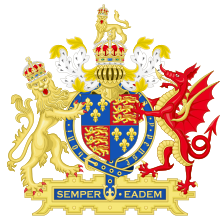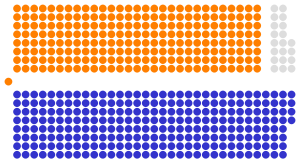
Back برلمان إنجلترا Arabic Parllamentu d'Inglaterra AST Парламент Англіі Byelorussian Парламент на Англия Bulgarian Det engelske parlament Danish Englisches Parlament German Parlamento de Anglio Esperanto Parlamento de Inglaterra Spanish Inglismaa parlament Estonian Englannin parlamentti Finnish
This article possibly contains original research. (August 2021) |
This article needs additional citations for verification. (March 2021) |
Parliament of England | |
|---|---|
 Royal coat of arms of England, 1558–1603 | |
| Type | |
| Type | |
| Houses | Upper house: House of Lords (1341–1649 / 1660–1707) House of Peers (1657–1660) Lower house: House of Commons (1341–1707) |
| History | |
| Established | c. 1236[1] |
| Disbanded | 1 May 1707 |
| Preceded by | Curia regis |
| Succeeded by | Parliament of Great Britain |
| Leadership | |
William Cowper1 since 1705 | |
John Smith1 since 1705 | |
| Structure | |
 | |
House of Commons political groups | Final composition of the English House of Commons: 513 Seats Tories: 260 seats Whigs: 233 seats Unclassified: 20 seats |
| Elections | |
| Ennoblement by the Sovereign or inheritance of an English peerage | |
| First past the post with limited suffrage1 | |
| Meeting place | |
 | |
| Palace of Westminster, Westminster, Middlesex | |
| Footnotes | |
| 1Reflecting Parliament as it stood in 1707.
See also: Parliament of Scotland, Parliament of Ireland | |
The Parliament of England was the legislature of the Kingdom of England from the 13th century until 1707 when it was replaced by the Parliament of Great Britain. Parliament evolved from the great council of bishops and peers that advised the English monarch. Great councils were first called Parliaments during the reign of Henry III (r. 1216–1272). By this time, the king required Parliament's consent to levy taxation.
Originally a unicameral body, a bicameral Parliament emerged when its membership was divided into the House of Lords and House of Commons, which included knights of the shire and burgesses. During Henry IV's time on the throne, the role of Parliament expanded beyond the determination of taxation policy to include the "redress of grievances", which essentially enabled English citizens to petition the body to address complaints in their local towns and counties. By this time, citizens were given the power to vote to elect their representatives—the burgesses—to the House of Commons.
Over the centuries, the English Parliament progressively limited the power of the English monarchy, a process that arguably culminated in the English Civil War and the High Court of Justice for the trial of Charles I.
- ^ a b Brand 2009, p. 10.
© MMXXIII Rich X Search. We shall prevail. All rights reserved. Rich X Search